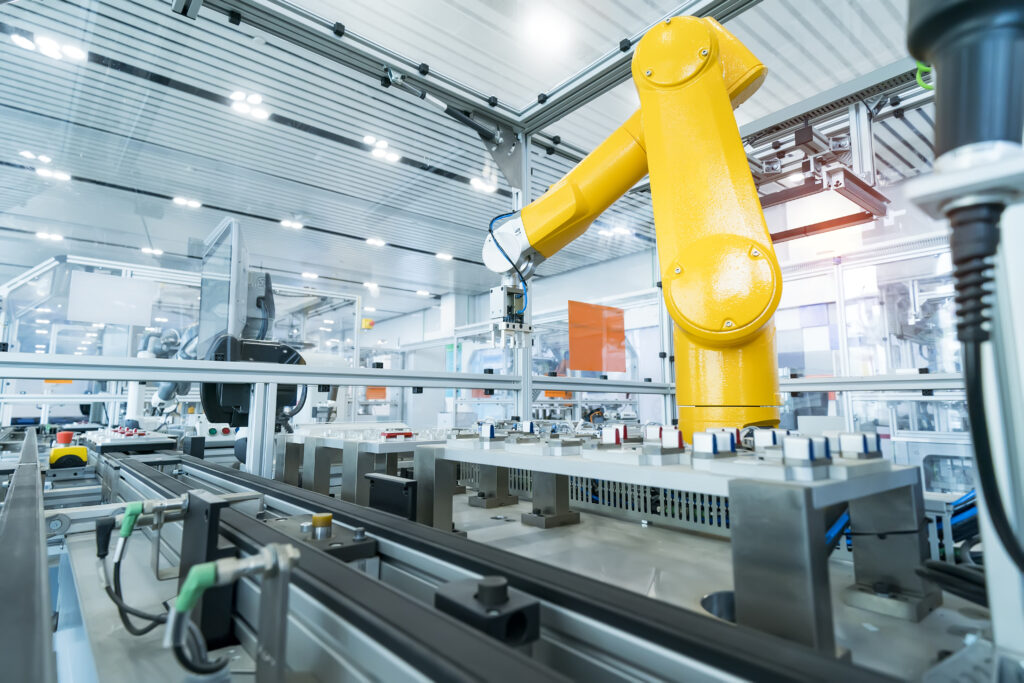
Building the Future
How Design and High Tech Are Reshaping Manufacturing Spaces — And Work Itself
The off-shoring trend in US manufacturing has been the topic of news reports, international politics and heated debate for decades. But as the world reenters the new normal business climate post-COVID crisis, societal shifts and the rise of advanced manufacturing are poised to bring about the end of off-shoring. As developing nations have grown in wealth and as the digitization of all aspects of manufacturing, or Industry 4.0, is taking hold across a range of sectors, the cost advantages of off-shoring for US manufacturers are diminishing. These factors, as well as the recent political climate, have inspired US companies to move production back to the US or to look to US locations for new production capacity. The COVID19 crisis will dramatically accelerate this trend.
But how will the return to manufacturing — including the factory job and the factory itself — take shape? What are the implications of these changes?
Workforce
While these shifts may not add to the number of manufacturing jobs in the US, they will fundamentally change the nature of those jobs, replacing hands-on labor with a need for technical skills and expertise. These changes, which have been taking place incrementally for years, are expected to accelerate dramatically in the coming decade — and they will lead to an increased demand in a challenging labor market.
Though the popular perception of manufacturing jobs often centers around job loss and the narrative of factory closures and Rust Belt towns, manufacturers across the US often struggle to hire and attract new talent.
This is due to a number of factors, including a retiring generation of workers who are leaving a void, a lack of well-trained, educated candidates for jobs that require more skill and technical knowledge than manufacturing jobs of the past and a societal bias against factory work.
That perception problem may be the most stubborn obstacle manufacturers face in attracting a modern workforce. Factory work has long been popular shorthand for production line work with repetitive, boring tasks and oppressive management. Manufacturing jobs are considered unreliable, with frequent layoffs. The workplace itself is thought of as dark, dirty and dangerous. For young, college-educated workers, factory jobs might not fit the image of the upwardly-mobile career track they have been trained to expect.
Manufacturers have battled this perception problem with hefty benefits packages and higher pay — on average 20% more in salaries for similarly experienced workers. They have also invested in recruitment, fostering partnerships with prestigious universities and in-house training programs. Yet they remain unable to fill open positions.
As on-shoring of manufacturing continues to grow and the market for increasingly skilled labor remains fiercely competitive, these staff shortages will escalate.
Technology
As companies move their production to the higher-cost US labor market, they will need to increase workforce productivity. This pressure will exacerbate another issue manufacturers across the US are struggling with — integrating the tools and processes of Industry 4.0 into their businesses.
Like most technological advances, the march of digitized industrial processes is inescapable. Across all manufacturing sectors, businesses are applying a wide variety of digital technologies to business functions from research and development to supply chain, production, warehousing, distribution and customer service.
Processing power and data storage have become more affordable over the last decade, driving the implementation of these systems forward and making it easier to incorporate them into a wide range of settings.
Both Gartner and KPMG have forecast significant growth in the application of a range of advanced technologies, from 3D printing (additive manufacturing), augmented reality and wearables, to advanced robotics, artificial intelligence, digital twinning, cyber security, and blockchain. The combined effect of these expanding technological capabilities will be a fundamental reconfiguration of manufacturing work and the production environment.
That change, while evolutionary, has begun to pick up speed. According to Klaus Schwab, head of the World Economic Forum, “it is the fusion of these technologies, AI, Big Data, IoT, bioinformatics, and their interaction across the physical, digital and biological domains that make the Fourth Industrial Revolution fundamentally different from previous revolutions — diffusing faster and more broadly than any of the previous revolutions.”
Workplace
The seismic shifts in the nature of manufacturing work and who performs it require a parallel rethinking of the environments in which that work occurs. Advanced manufacturing facilities will function and look much more like laboratory or office-like settings than a traditional factory floor, while the actual production area will have fewer people performing tasks. Workers will be engaged in different tasks — less repetitive line work, more production planning, programming, customer service, sales, product development and engineering.
Production equipment and processes will be automated and require little direct supervision by workers. The staff in the plant will no longer work on an assembly line executing repetitive tasks. Rather they will develop, program, maintain and repair production equipment; plan production processes; coordinate receiving of materials and supplies and facilitate shipping of finished products. They will monitor quality control and constantly revise production plans to improve quality.
In “The Service Factory,” a Harvard Business Review article from 1989, authors Richard B. Chase and David A. Garvin anticipated that manufacturers would enhance their competitiveness by bundling services with products to respond to a comprehensive range of customer needs.
They posited that the up-skilled worker on the factory floor would make essential contributions to product development, sales and marketing, quality control and customer service: “Factories generate information and skills that are critical for product design. Among them are accurate and timely feedback on the manufacturability of new designs, the ability to construct prototypes quickly, and the capability of introducing engineering change orders smoothly. But factories are also a resource for helping customers with installation, maintenance, and troubleshooting. The people who make products are often more knowledgeable about their performance, variability, and repair than the people in field service.”
As these departmental responsibilities continue to overlap and manufacturers look to tap the capabilities and talents of all employees, the advantages of bringing these functions into the same location will become obvious, and headquarters will come to the factory.
What does the Service Factory that supports Industry 4.0 look like?
Let’s start with the footprint: Industry 4.0 facilities will typically be smaller than the common notion of the single plant that receives raw materials at one end and spits out products at the other end.
Location will gain added importance, with some companies choosing to keep facilities closer to customers so they can be more responsive to shifting demand. In addition, urban centers will be desirable for their attractiveness to a highly educated workforce, a workforce that is drawn to and supported by advanced educational opportunities at universities, quality of life advantages in larger markets, and ready access to local commuting and global transportation networks.
Advanced manufacturing facilities will be enmeshed in a complex supply chain that includes a wide variety of product and service suppliers who are both local and global. It will be immediately responsive to local customers but may also serve global customers across low cost logistics networks that add marginal cost to the product.
The heart of the facility will still be a production floor, supported by utility spaces and distribution systems, shipping and receiving facilities. This production space will be flexible to accommodate changing production requirements. Through the use of modular planning, inherent and almost limitless flexibility can be built in. The facility can be incrementally scaled up or down in response to demand or changes in product. Production can change in some modules and remain consistent in others.
The highly skilled workers in an Industry 4.0 facility will expect their workplace to match the character of any technology employer with comfortable, attractive office space, amenities and meeting and gathering spaces designed to support a collaborative working environment. And, as in other tech companies, the workplace will become a recruitment tool, helping to change perceptions about factory jobs and, ultimately, ease the manufacturing workforce crunch.
Our recent project for a high technology client illustrates many of these requirements and design responses. Drawing on strategies and insights developed in our long experience with data center construction, simplicity and flexibility are key watchwords throughout the building design — yet not at the expense of the creation of a sense of place and corporate identity.
This future-facing factory is designed around the efficient layout of production equipment and strategies for delivering multiple utility connections from service spaces to this equipment on the production floor. The design establishes both overhead and underfloor layered flyways for each utility system on simple, flexible support systems. Mechanical and electrical systems are designed around modules or blocks to provide both current redundancy and future flexibility. Modular design allows for shifting production capabilities over time, and creates space and infrastructure for the next wave of technological advances, creating increased longevity and value.
Beyond the production floor, the building program includes mechanical and electrical support spaces, lab space and a clean room along with locker rooms, offices and conference rooms, supporting the functions of a technology-driven operation and workforce. Operations are overseen at a central command center where workers can monitor every aspect of production and building performance.
That strong foundation of seamless technological integration allows for the project’s higher ambitions. Guided by a search for simplicity of form, the building is conceived as a simple box carved away to reveal and recall the faceted structure of the client’s products. Facets are split at the two story office zone to express the two floors behind. Fritted glass panels reinforce the white color of the exterior wall panels and louver screens, and the minimal aesthetic is reinforced by smooth white stucco wall panels detailed with crisp edges on a uniform module reflecting the structural bays inside. The design provides instantly recognizable references to corporate identity, and an aesthetic that places the facility within the visual vocabulary of the high-tech world.
The heart of the office area is a multifunction space that accommodates dining, training and all-hands meetings or socializing, meeting the expectations and needs of the highly skilled workforce. Second floor office spaces are connected to first floor activities with glazed overlooks on the production floor and open walkways above the staff gathering and meeting areas. Unlike the stereotypical grim, looming factories of the past, this workplace is a welcoming, inspiring place that enables productivity and focus as well as collaboration — ultimately creating an environment that not only fosters workplace satisfaction but aids in talent acquisition.
Though the changes facing manufacturing sector businesses and facilities are considerable, the lessons offered by high tech industries and data center design, combined with insights gleaned from the vanguard of advanced manufacturing facilities design, point the way to a more flexible, nimble, human-centric factory. The Industry 4.0 factory incorporates the requirements of high technology, the demands of the manufacturing economy and the needs and wants of workers — and it presents considerable opportunity for manufacturing companies to redesign and reshape not only the workplace, but the nature of the work itself.

